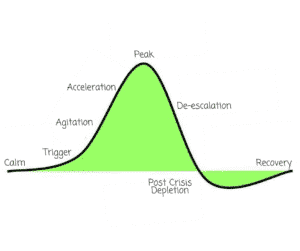Emotional Regulation & The Brain
As a parent I know only too well how hard and stressful it is when your child is having a tantrum or meltdown. As parents we try to reason with our child or continue to say no to their demands when they are showing unwanted behaviour.
We expect them to be able to control their feeling and emotions in the same way an adult would, but if your child or toddler could tell you how they were feeling during their meltdown, it would be something like this:
- I have a child’s brain in a child’s body
- I don’t have an adult’s brain in a child’s body
- Please don’t make me feel ashamed or like I have done something wrong
- When I can’t yet manage my emotions and express my feelings in the same way you can.
- Please remember I’m just a child and I need you to help me regulate and make sense of my emotions and feelings.
The Escalation Cycle
Although meltdowns or tantrums may seem unpredictable, or like they happen out of nowhere or for no apparent reason, there is a clear pattern that happens before, after, and during a child’s meltdown.
The diagram shows the pattern of The Escalation Cycle.
Sometimes, when children become extremely overwhelmed or they’re experiencing sensory overload, they have a meltdown where they lose control over their behaviours.
These situations are stressful for everyone involved but if we are patient, calm and stay in control of our own emotions we will help children to understand the different emotions they are feeling and help them to manage them in a positive way.
The He’s Extraordinary website has free downloadable sheets about how various sections of the brain are used and how that affects a child’s emotional regulation. You can also read their blog post on How to stay calm when your child isn’t.



